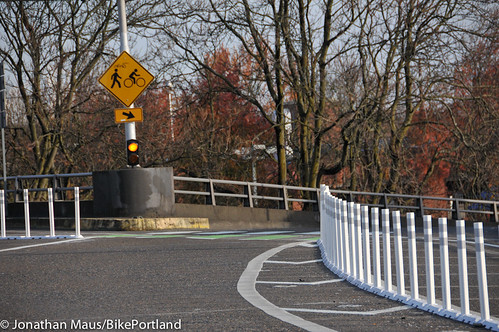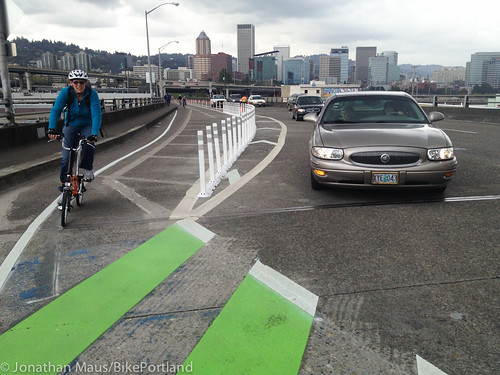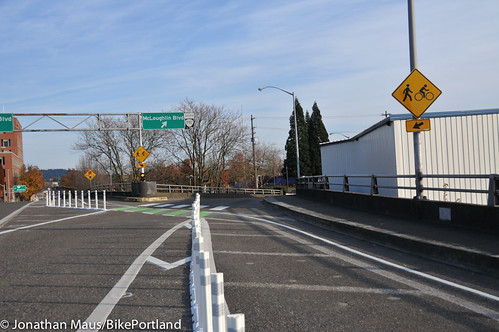
(Photos by J. Maus/BikePortland)
A man whose right elbow was broken in a collision on the recently redesigned Hawthorne-Madison viaduct last week says he thinks the new design is confusing for motor vehicle operators and puts bicycle riders like him at risk.
Early last month, city and county workers collaborated to widen the bike lane, add a walking lane and add a tightly spaced row of plastic “candlestick” delineators to separate bike and auto traffic.
But Carl Batten, who was injured last Thursday, thinks the posts are causing people to be less cautious in avoiding collisions when they bear right onto McLoughlin.
“They see bikes on the right of them, they see this picket fence separating them, they see the picket fence curving to the right, and they just assume that they’re going to continue to be separated from them as they go down the ramp,” Batten said in an interview Tuesday.
Batten said he walked along the posts after his injury to understand the new design from the perspective of a person driving a car.
“As you’re on there, you really can’t see where the bike lane goes,” Batten said. “That row of bollards curves, and as far as you can see when you’re approaching it. You can’t see down the ramp. There’s no visual indication that the bike lane is going to cross the ramp until you’re right there.”
Batten said he was hit on that crosswalk at about 4:40 pm, when it was dark enough for him to have turned on his front and rear blinking bike lights and for most cars to have headlights on.
“I think I was going somewhere between 10 and 15 miles per hour – I wasn’t moving very fast,” Batten said. “And traffic was moving at approximately the same speed. It was getting a bit thick.”
A car struck Batten when he was about a third of the way across the green-striped bike crossing. Though he’s unsure how it happened, he fell on his right arm, fracturing the head of his radius and possibly also breaking a bone in his wrist.
“Somehow my bike must have gone over me, because I hit my right arm but I ended up with my feet pointing down the ramp and my bicycle on top of me,” he said.
Batten has received treatment and is recovering.
Batten, who works as an economist for a private company downtown, said he isn’t sure of the best way to make the design better, but thinks it needs some sort of change. The basic problem, he said, is that “the cars that are on their way down the ramp are on the way down the ramp already when they get to the point where the car lane crosses the path.”
“There’s no message to drivers that they have to yield to bikes,” Batten said. “I don’t know what the best way to convey that message is, but I think better signs, and at least one sign that has the word yield in it, and then maybe not having the bollards curve around and then maybe move the crossing a little bit further north along the ramp.”
Here’s a shot of the old signs:

And the new ones:
The bike crossing, he noted, “makes an S-turn when before it used to go more or less straight across.”
Batten said he’s tried to contact the city and county to alert them to the problem, but made little progress.
“I haven’t been able to reach any of them, because it’s the county’s road but they rely on the city to help them, and there’s not always clear communication between the two,” he said.
Batten’s experience is worrisome. Though protected bikeways can be great for comfortable biking, they have the opposite effect when the designs aren’t intuitively usable by everyone on the road. And in this case, the shared authority for this design between the city and county may make it harder to get things right. We hope they give this a close look and make any changes that might be needed.
Update 11/21: Andrew Holtz of the county bike-pedestrian advisory committee says the committee will review the design and adds in a comment below: “The staff liaison is Kate McQuillan. Her phone number is 503-988-5050, extension 29397. Information about the committee and county bike/ped contacts is available on the Multnomah County website.”




